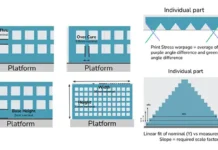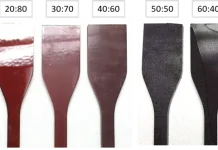By Sara M. Kaalberg and Julie L. P. Jessop, Department of Chemical & Biochemical Engineering, University of Iowa
Editors Note: The following received RadTech 2016’s Best Student Paper Award at the event held May 16-18 in Chicago, Illinois.
Abstract
Cycloaliphatic epoxides (oxiranes) typically polymerize more slowly than acrylates and tend to be brittle. However, cationic active centers are long-lived, resulting in significant dark cure. Here, oxetane addition to formulations is correlated to improvements in polymerization kinetics and polymer properties during dark cure. Raman spectra yielded conversions; DMA provided Tg and crosslink density. Increasing oxetane concentrations improved epoxide conversion and drastically lowered Tg of the resulting polymers, thereby increasing the application range for cycloaliphatic epoxides.
Introduction
Cationic photopolymerization offers unique advantages for many applications. For example, these systems are not inhibited by oxygen and are essentially nonterminating, leading to very long active-center lifetimes (hours or even weeks). In contrast, free radicals generally have propagating lifetimes on the order of seconds, due to rapid radical-radical termination reactions or oxygen- quenching reactions, both of which quickly consume the free-radical active centers. As a consequence of the long-lived active centers, cationic polymerization may proceed long after the irradiation has ceased, leading to dark cure or post-illumination polymerization. This dark cure results in further property development over the course of hours or days and is due to the active centers lasting long enough to be controlled by diffusion and having the ability to travel further away from the areas that were initially irradiated, both deeper into the coating and into areas that were never irradiated.1

The use of oxetanes in conjunction with epoxides (also known as oxiranes) has the potential to decrease chain transfer during polymerization and enhance physical properties. During ring-opening polymerization, the ring in the growing polymer chain is opened, while the attacking molecule remains intact, so the competition between the monomer and polymer is governed primarily by the nucleophilicity of the oxygen atom in cyclic and linear structures.2 Because epoxides and linear ethers have very similar pKa values (Figure 1), the active centers have almost equal affinity for both the unreacted monomer functional groups and the polymer chains.3 Thus, competition between the monomer and polymer chains is a problem in epoxide systems, and chain transfer to polymer is typical in cationic ring-opening polymerizations containing epoxides. Intramolecular reaction leads to cyclic monomers, while intermolecular reaction leads to segmental exchange, or “scrambling.”4 Both of these chain transfer reactions lead to broadening of the molecular weight distribution, which is not favorable. This research examines the effects of combining oxetanes and epoxides on the reactivity of each monomer, the overall reaction kinetics, and the final physical properties of the polymer films, while reducing illumination time and exploiting dark cure in these systems.
Experimental
Materials

Methods
Formulations and experimental variables
Experiments were performed to determine effects of various formulation factors, including oxetane concentration, liquid monomer viscosity, and comonomer functionality. The oxetane concentration ranged from 0 mol% (i.e., 100% EEC) to 60 mol% (i.e., 40 mol% EEC) in increments of 20 mol%. Because oxetanes have significantly different viscosities and plasticizing ability in EEC, equal viscosity formulations of 200 cP and 300 cP were also compared for each of the oxetanes in EEC.
Raman spectroscopy
Raman spectroscopy was used to monitor simultaneously epoxide and oxetane conversion, both during UV illumination and at specific time intervals after the light had been shuttered (dark cure).5 Samples were injected into 1mm-ID quartz capillary tubes and illuminated with a mercury arc lamp fitted with a 250-450 nm filter (Acticure® Ultraviolet/Visible Spot Cure system, EXFO Photonic Solutions Inc.) for 10 minutes at an effective irradiance of 710 mW/cm2 and measured with a radiometer (R2000, Omnicure, wavelength range 250nm 1µm). Real-time Raman spectra were acquired using a holographic probe head (Mark II, Kaiser Optical Systems Inc.) with a single-mode excitation fiber delivering ~220 mW of 785-nm near-infrared laser intensity to the quartz capillary tubes. The spectra were collected with a 1-s exposure time and 3 accumulations. Additionally, spectra were taken at various time points after illumination had ceased to measure any conversion increases and determine how each formulation affected dark cure over the course of hours and days. Dark cure was followed for up to four hours after illumination ceased in 5- to 15-minute increments. Conversions taken 24 to 72 hours after illumination did not exceed an additional 5% conversion from the four-hour measurements for any formulation.
Conversion was calculated from the Raman spectra using Equation 1. The epoxide reaction peak was measured at 790 cm-1, the oxetane reaction peak at 1150 cm-1, and the reference peak for both monomers at 1450 cm-1. This stable reference peak is used to eliminate error due to baseline changes. In Equation 1, I(t) denotes the peak intensity at time t, and I(0) represents the initial peak intensity. The subscripts denote whether the measurement is of the reaction peak intensity (rxn) or the reference peak intensity (ref).
Dynamic mechanical analysis

Dynamic mechanical analysis (DMA) was used to compare the glass transition temperature (Tg) and network homogeneity of neat EEC to formulations containing both epoxide and oxetane. The procedure has been described previously.6 DMA films were made by injecting the formulations between two microscope slides (separated by two cover slips) and photopolymerizing under a belt-driven Fusion curing system fitted with an H bulb with an effective irradiance of 180 mW/cm2, as measured with the radiometer. The films were passed at 8 ft/min under the lamp three times for each side. The resulting films were 0.30 mm in thickness and were cut into rectangles measuring approximately 20 x 5 mm. Each film was allowed to dark cure for multiple weeks to ensure a final room-temperature conversion before testing. As noted above, conversion increases were 30° C under the neat oxetane Tg (see Table 1) to 250° C (i.e., 50° C above the neat epoxide Tg) at a sinusoidal strain of 0.05% applied at a frequency of 1 Hz. Each film underwent two thermal cycles to determine if annealing was present and how it affected the Tg.
Results and discussion
Impact of dark cure on kinetic results

The epoxide EEC generally shows low conversions in neat formulations (less than 10% during the first 10 minutes of illumination; less than 40% final conversion after four hours). Long illumination times are not required to get full property development or to speed the reaction, as the conversion profile is similar between a sample illuminated for four hours and one illuminated for 10 minutes and allowed to dark cure for four hours (Figure 3). Thus, once the cationic active centers have been generated, there is no need to continue illumination, and reduced energy costs are realized. However, a large proportion of monomer conversion and property development can occur in the time following illumination, and the impact of dark cure must be considered.

The neat oxetanes have long induction periods (on the order of minutes). Combining EEC with any of the oxetanes decreased the oxetane induction period and increased the conversion for both monomers in each formulation. The enhancement in oxetane reactivity stems from the epoxide functional groups acting as reactive sites for the initiation of the oxetane functional groups.7,8 For example, in the difunctional EEC/monofunctional POX formulation series, increasing the proportion of oxetane results in increased epoxide conversion (Figure 4) – both at the end of the illumination period (values along the y axis) and during dark cure. The impact of the epoxide on the kinetics of the oxetanes is more

complex (Figure 5). For the neat monomer formulation, the reaction proceeds more slowly, with only 10% oxetane conversion occurring during illumination and a final oxetane conversion approaching 30% after three hours of dark cure. Compared to the neat oxetane, the epoxide/oxetane mixtures have higher oxetane conversions during illumination (> 15%), as well as faster polymerization and a reduced induction period (not shown in Figure 5), and final oxetane conversions are achieved much more rapidly in the dark (i.e., within one hour of shuttering the light).

The other three oxetanes behave similarly (i.e., increased epoxide conversions result from increased proportions of oxetane in the formulation) to varying degrees. DOX, the difunctional oxetane, does not greatly enhance the epoxide conversion, although the dark-cure conversion of the oxetane greatly benefits from the presence of the epoxide (Figures 6 and 7). Neat DOX formulations achieve only 5% conversion by the end of the illumination period but show very high dark-cure conversion.

Shorter illumination times at lower intensities result in longer induction periods, but as soon as the reaction reaches a threshold conversion, high conversions are obtained quickly. In contrast to neat DOX, a 40:60 EEC:DOX formulation reaches almost 70% oxetane conversion during the same 10-minute illumination period, and less conversion increases are seen post-illumination. DOX does not enhance epoxide conversion as much as the other oxetanes because the initial formulations are highly viscous and a heavily crosslinked network is formed upon illumination of the two difunctional monomers, which traps the active centers and limits reactive diffusion. The functionality of the oxetane monomer, therefore, must be considered when choosing the comonomer for polymerization with EEC. Monofunctional oxetanes enhance the kinetics and conversion of EEC to a higher degree than difunctional oxetanes, reducing the need to illuminate for long periods of time and to wait for physical property development post-illumination.
Impact of Oxetane Addition on Tg.

Two thermal cycles were necessary for most formulations due to the long-lived nature of cationic active centers.9 The addition of oxetanes has the potential to greatly reduce the Tg of a copolymer film by up to 100° C, resulting in films that are much less brittle than neat EEC. The second thermal cycle resulted in Tg increases of 5° C for EEC, demonstrating that some reaction occurs during the first cycle, which incorporates additional monomer into the polymer matrix. The amount of annealing in the copolymer that occurs during the first thermal cycle depends on both the epoxide-oxetane formation ratio and the oxetane monomer structure. For example, as the amount of POX is increased, the change in Tg from the first to second thermal cycle decreases (Figure 8). As the amount of POX increases, the formulation viscosity decreases, and higher conversions are attained for both EEC and POX prior to DMA measurements (Figures 4 and 5); therefore, less annealing is possible due to these advanced network restrictions. Even less annealing is observed for the EEC/DOX system, since both monomers are difunctional.
Additionally, formulation viscosity affects the Tg but the extent depends on the comonomer. Equal viscosity formulations result in similar Tg changes from the first to second cycle, but the Tg values for formulations with the same viscosity can vary up to 20° C for the different oxetane comonomers. For example, in comparing 200 cP formulations of EEC/POX and EEC/DOX, each ΔTg was 6° C; however, the Tg for the first cycle of EEC/POX was 124° C, while EEC/DOX was 145° C. In these equimolar and equal viscosity studies on the physical properties of polymer films, monofunctional oxetanes are better able to lower viscosity and decrease the Tg of EEC, since difunctional oxetane monomers create a highly crosslinked network upon polymerization, causing them to be less effective in lowering the Tg.
Conclusions
Once cationic active centers are produced, continued illumination is not beneficial reaction time and ultimate conversions after dark cure are similar to those after full illumination periods. In fact, most EEC conversion and its corresponding polymer property development can occur during this dark cure period, which results in lower energy requirements. However, the time required to reach these ultimate properties in EEC is still long (on the order of hours).
Combining epoxides and oxetanes greatly increases kinetics for both monomers, lowering illumination time and dark cure needed to reach final polymer properties. In the series of comonomer formulations examined here, increasing the proportion of oxetane in the formulation resulted in acceleration of the EEC polymerization and lowering of the final polymer Tg. Monofunctional oxetanes were more effective than multifunctional oxetanes in realizing these benefits due to lower initial viscosities and less restricted network formation.
Acknowledgements
This material is based on work supported by the Fundamentals & Applications of Photopolymerizations Industry/University Cooperative Research Center. We would like to thank Changzhou Tronly New Electronic Materials, Toagosei and Polyset for their generous donation of materials.
References
- Ficek, B.A.; Thiesen, A.M.; and Scranton, A.B. Cationic photopolymerizations of thick polymer systems: Active center lifetime and mobility. Eur. Polym. J. 2008; 44(1):98-105. doi:10.1016/j.eurpolymj.2007.10.023.
- Sasaki, H.; Rudzinski, J.M.; and Kakuchi, T. Photoinitiated cationic polymerization of oxetane formulated with oxirane. .J Polym. Sci. Part A Polym. Chem. 1995; 33(11):1807-1816. doi:10.1002/pola.1995.080331107.
- Kubisa, P. 4.08 – Cationic Ring-Opening Polymerization of Cyclic Ethers. Vol 4. Elsevier, B.V.; 2012. doi:http://dx.doi.org/10.1016/B978-0-444-53349-4.00102-3.
- Kubisa, P.; Penczek, S. Cationic activated monomer polymerization of heterocyclic monomers. Prog. Polym. Sci. 1999; 24(10):1409-1437. doi:10.1016/S0079-6700(99)00028-3.
- Cai, Y.; Jessop, J.L.P. Decreased oxygen inhibition in photopolymerized acrylate/epoxide hybrid polymer coatings as demonstrated by Raman spectroscopy. Polymer (Guildf). 2006; 47(19):6560-6566. doi:10.1016/j.polymer.2006.07.031.
- Dillman, B.; Jessop, J.L.P. Dillman [2013] Cationic CTAs.pdf. J. Polym. Sci., Part A Polym. Chem. 2013; 51:2058- 2067.
- Crivello, J.V. Kick-Starting Oxetane Photopolymerizations. J. Polym. Sci., Part A Polym. Chem. 2014;52(20):2934-2946. doi:10.1002/pola.27329.
- Crivello, J. V. Investigations of the reactivity of kick-started oxetanes in photoinitiated cationic polymerization. J. Polym. Sci., Part A Polym. Chem. 2014; 53(4):586-593. doi:10.1002/pola.27479.
- Sipani, V.; Scranton, A.B. Dark-cure studies of cationic photopolymerizations of epoxides: Characterization of the active center lifetime and kinetic rate constants. J. Polym. Sci., Part A Polym. Chem. 2003; 41(13):2064- 2072. doi:10.1002/pola.10750.






